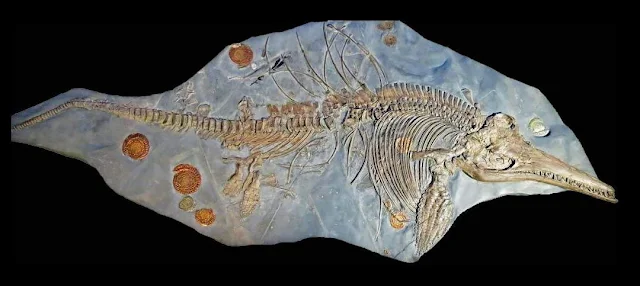Largest Ichthyosaurus Fossil Ever Found Was Pregnant
 |
| Skeleton of Ichthyosaurus. Credit: Copyright Dean R. Lomax |
Mislabelled Fossil With a Fake Tail Turned Out to Be the largest Ichthyosaurus on record and found it was pregnant at the time of death.
The new specimen is estimated to be between 3 and 3.5 m long and is an adult female. Ichthyosaurs were a highly successful group of sea-going reptiles that became extinct about 90 million years ago. Often misidentified as swimming dinosaurs, these reptiles appeared before the first dinosaurs had evolved. The largest species of ichthyosaur grew to over 20 m in length.The new specimen was originally discovered on the Somerset coast, during the mid-1990s, and is from the Early Jurassic, roughly 200 million years old. However, the specimen remained unstudied until it wound up in the collections of the Lower Saxony State Museum in Hannover, Germany.
They identified it as an example of an Ichthyosaurus somersetensis, a new species that Dean and another colleague, Prof. Judy Massare, had previously identified.
Dean said "It amazes me that specimens such as this [the biggest] can still be 'rediscovered' in museum collections. You don't necessarily have to go out in the field to make a new discovery. This specimen provides new insights into the size range of the species, but also records only the third example of an Ichthyosaurus known with an embryo. That's special"
The embryo is incomplete and preserves only a portion of the back bone, a forefin, ribs and a few other bones. The preserved string of vertebrae is less than 7 cm long. The bones of the embryo are not fully ossified, meaning that the embryo was still developing.
Another intriguing discovery the duo made was that the tail of this new specimen did not belong with the rest of the skeleton. A tail from another ichthyosaur had been added to the skeleton to make it appear more complete and visually appealing for display.
"Specimens like this provide palaeontologists with important information about when these animals lived. Many examples of Ichthyosaurus are from historical collections and most do not have good geographical or geological records, but this specimen has it all. It may help to date other ichthyosaur fossils that currently have no information."
Ichthyosaurus is one of the most common fossil reptiles in the UK, with thousands of specimens known, ranging from isolated bones to complete skeletons. Some of the very first examples were collected from along the Dorset coast by Victorian palaeontologist, Mary Anning, who first brought them to the attention of the scientific world.
The above story is based on Materials provided by University of Manchester.

%20(1).webp)






